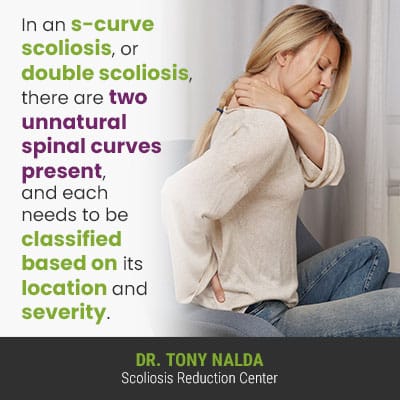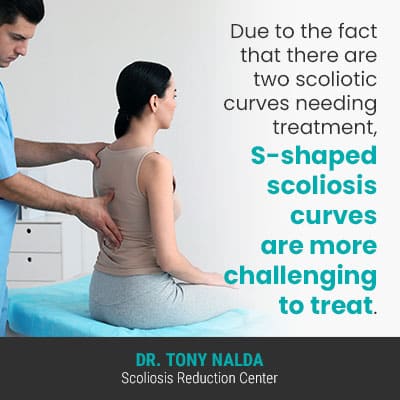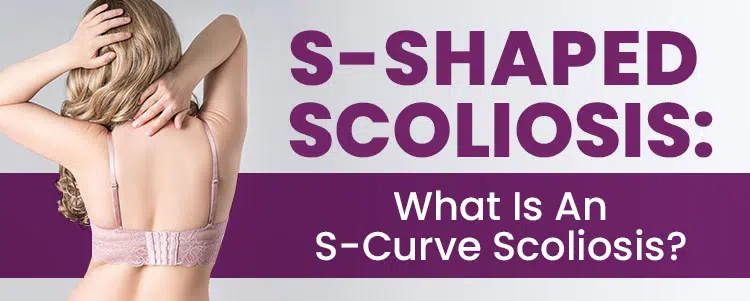When scoliosis is first diagnosed, part of the process involves comprehensively describing and classifying conditions based on important patient/condition characteristics. Scoliosis can affect any section of the spine, and S-shaped scoliosis can involve multiple sections, which is why treatment is more complex for an s-curve, than a c-curve.
Not only are there different forms of scoliosis, but there are also different types of scoliosis curves, and an s-shaped scoliosis, also known as an S-curve scoliosis, or double-curve scoliosis, is just that: a scoliotic curve that bends in two directions and is more complex than a C-shaped scoliosis.
Before getting to the specifics of different types of scoliosis curves, let’s first ensure we have a foundational understanding of the condition itself.
Understanding Scoliosis
If a person is diagnosed with scoliosis, this means they have developed an unnatural sideways spinal curve, with rotation and a minimum Cobb angle of 10 degrees.
Cobb angle is a key classification point for all types of scoliosis and scoliosis curves because it indicates how severe a condition is based on how misaligned the spine is and its level of flexibility:
- Mild scoliosis: Cobb angle measurement of between 10 and 25 degrees
- Moderate scoliosis: Cobb angle measurement of between 25 and 40 degrees
- Severe scoliosis: Cobb angle measurement of 40+ degrees
- Very-severe scoliosis: Cobb angle measurement of 80+ degrees
The Cobb angle is measured by drawing lines from the tops and bottoms of the curvature’s most-tilted vertebrae, and the intersecting angle is measured in degrees.
The rotational component means a scoliotic spine doesn’t just bend unnaturally to the side. It also twists from front to back, back to front, making it a 3-dimensional condition.
In a C-shaped scoliosis, a single scoliotic curve bends to the right, away from the heart, also known as dextroscoliosis, and when a single C-curve scoliosis bends to the left, towards the heart, this is known as levoscoliosis, is considered atypical, and indicates an underlying pathology.
In the vast majority of known diagnosed scoliosis cases (approximately 80 percent), we don’t fully understand why they initially develop, classified as idiopathic scoliosis, and in the remaining 20 percent, these forms are associated with clear causative sources: neuromuscular, congenital, degenerative, and traumatic scoliosis.
It is important to understand, however, that in cases of idiopathic scoliosis, even though we might not fully understand its etiology, we know how to treat it effectively, and having clear causation wouldn’t necessarily change the course of treatment, nor its outcome. What’s more important is how a condition is responded to, following a diagnosis, in terms of treatment.
Scoliosis is also progressive, meaning it is very likely to worsen over time, particularly if left untreated or not treated proactively.
The spine has three main sections: cervical (neck), thoracic (middle/upper back), and lumbar (lower back).
Part of classifying scoliosis involves its location within the spine, and while scoliosis can develop in any spinal section, when an S-curve scoliosis comes into play, as a double curve scoliosis, multiple spinal sections can be involved.
What is an S Curve Scoliosis?

In an S-curve scoliosis, or double scoliosis, there are two unnatural spinal curves present, and each needs to be classified based on its location and severity.
Spinal flexibility is also an important factor because as scoliosis progresses, the unnatural curve(s) increases in size, becoming more rigid, meaning the spine becomes less flexible, and a decreased range of motion in the affected area is likely.
Spinal rigidity also makes the surrounding muscles sore and strained as they struggle to support an unnaturally curved and stiff spine.
Curves that don’t reduce when bending towards the side the scoliotic curve is bending towards (convex side/convexity) are stiff and rigid, making them less responsive to treatment and more complex to treat. This is another reason proactive treatment is so important because, when successful, it can prevent further progression, which is known to increase spinal rigidity.
Double Curve Scoliosis Location
As mentioned, scoliosis can develop in any of the spine’s main sections (cervical, thoracic, and lumbar).
The location of a double curve scoliosis is an important classification point that helps shape the crafting of customized treatment plans, and as it involves two different curves bending in opposite directions, more than one spinal section can be involved. For example, if a double scoliosis starts in the lower middle/upper back and the upper lower back, this is classified as an s-shaped thoracolumbar scoliosis.
Scoliotic curve location is best assessed by using what’s known as the plumb line. As an S-curved spine presents with two scoliotic curves, each bends to the opposite side. The two curves are classified as minor or major curves, the major being the more significant of the two: the minor curve being the smaller of the two.
Put simply, one of the two curves will always be more dominant. When it comes to lumbar curves (lower back), these tend to be larger than the curves of the upper and middle back (thoracic spine), but there are times when thoracic curves are more prominent than the curves of the lumbar spine.
Why is a Double Curve Scoliosis More Complex to Treat?
As a progressive condition, proactive treatment applied as close to the time of diagnosis as possible is important.
While early detection and proactive treatment doesn’t guarantee treatment success, it does increase its likelihood as there are fewer limits to what we can achieve when treating a scoliosis while it’s at its smallest, prior to significant progression, increasing spinal rigidity, and before the body has had ample time to adjust to its presence.
Here at the Scoliosis Reduction Center®, I believe in the merits of a conservative treatment approach that applies proactive treatment in an effort to counteract the condition’s progressive nature.
When it comes to crafting effective treatment plans, customization is key because no two cases of scoliosis are the same; not only are there different types of scoliosis, there are multiple different types of scoliosis curves and curvature patterns that can dictate treatment needs.
When it comes to treating an S-curve scoliosis, a comprehensive assessment to determine which of the two unnatural spinal curves is the more dominant is the first step, and as there are two curves in two sections, bending in opposite directions, the rotational component tends to be more severe.
By addressing the condition’s true 3-dimensional nature, a modern conservative approach also addresses one of the main shortfalls of traditional treatment: treating the condition as 2-dimensional, not accounting for the rotational component.

Due to the fact that there are two scoliotic curves needing treatment, S-shaped scoliosis curves are more challenging to treat.
While there are no treatment guarantees, integrating different treatment disciplines has corrective potential as it can impact the condition on multiple levels.
By combining condition-specific chiropractic care, in-office therapy, custom-prescribed home exercises, and corrective bracing, I can target the more dominant curve initially and then work towards reducing both curves on a structural level for the best potential results.
Conclusion
Part of the reason scoliosis is so often deemed a complex condition is because it develops across a wide severity spectrum. There are multiple condition types, and multiple different types of scoliosis curves and curvature patterns.
Regardless of type, scoliosis is progressive, meaning it’s in its very nature to worsen over time, particularly if left untreated or not treated proactively.
Here at the Scoliosis Reduction Center®, I have experience treating a wide range of spinal conditions and different types of scoliosis, including the complex S curve scoliosis.
The spine’s natural curves make it stronger, more flexible, and better able to absorb/distribute stress incurred during movement, so when the spine develops one or more unhealthy curves, its optimal health and function is disrupted.
As a structural spinal condition, scoliosis has to, first and foremost, be impacted on a structural level, and with an S-curve scoliosis, this involves a double curve in two different spinal sections that bend in opposite directions in an ‘S’ shape.
Also known as a double curve scoliosis, S-curve scoliosis involves two curves, one that’s more prominent, and another that’s smaller. Part of potential treatment success involves first targeting the dominant curve, and then working towards reducing the smaller one as well, while restoring as much of the spine’s healthy curves and biomechanics as possible.
If you, or someone you care about, is living with an S-shaped scoliosis, there are many potentially-effective treatment options available.





